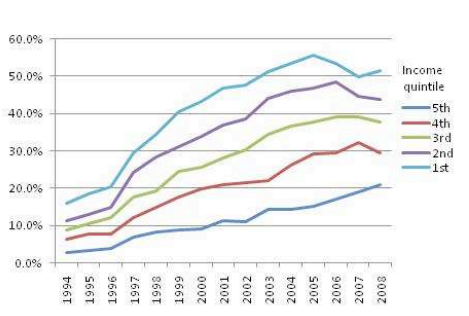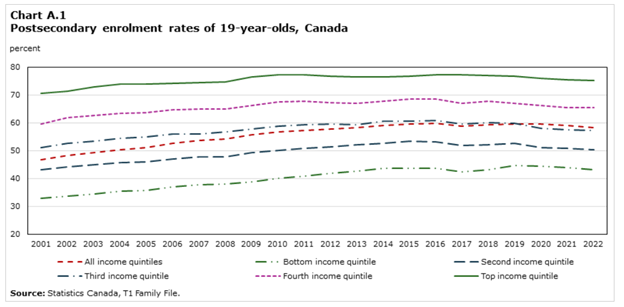One of the things that I find extremely worrying about higher education policy these days is that we’ve simply stopped talking about increasing access to the system. Oh, sure, you will hear lots of talk about affordability, that is, making the system cheaper—and hence arguments about the correct level of tuition fees—but that’s not the same. Even to the extent that these things did meaningfully affect accessibility (and it’s not at all clear that they do), no one phrases their case in terms of access anymore. We don’t care about outcomes. And I do mean no one. Not students, not governments, not institutions. They care about money, cost, all sorts of things—but actual outcomes with respect to participation rates of low-income students? At best, they are a rhetorical excuse to mask regressive spending policies which benefit the rich.
This is a problem because it now seems as though the process of widening access, a project which began after World War II and has been proceeding for seven decades. And yet, as some recently-released Statistics Canada data shows, participation rates are now actually in decline in Canada. And it’s mainly because growth at the bottom has stalled.
Below is the chart StatsCan released last month. It shows the post-secondary enrolment rate for 19-year-olds, which I will henceforth refer to as the “part rate” or “participation rate,” both for the entire population (the dotted red line) and by income quintile.
Now, the first thing you may notice is that there are some pretty big gaps between the participation rates of youth from rich and poor families; the top quintile does not quite attend at double the rate of the lowest quintile, but it’s close. And you might be tempted to say, “Hey, I’ve taken Econ 101—That must be because of tuition fees!” Except, no. These kinds of part-rate disparities are pretty common internationally, regardless of tuition fees. Here are postsecondary enrolment rates by income quintile from the United States, which, on the whole, has higher fees than Canada:

And here’s a similar chart from Poland, which mostly offers education tuition-free:

And here’s one from France, where public universities are tuition-free but students are increasingly heading to the fee-paying private sector:

I could go on, country-by-country, but I will spare you and instead point you to this rather good paper doing a cross-national analysis across over 100 countries by OISE’s Elizabeth Buckner. Trust me, it’s the same story everywhere.
But let me point out what I think are the two important points in that chart. The first is that the red dotted line, which represents the participation rate of all 19-year-olds, basically plateaued back in about 2014, the first year it broke the 59% and is currently headed downwards. This is a huge change from the previous period, 2000-2014, when overall participation rates rose from 46% to 59%. First growth, now stagnation.
The second is that during the growth period, the biggest strides were being made at the bottom end of the income scale. The part rate gap between top and bottom quintiles fell from 38 percentage points in the early 2000s to about 32 percentage points in 2014, even as part rates for the wealthiest quintile increased. That is to say, more of our growth came from the bottom than from the top. That’s good! But the growth stopped across all income quintiles and went gently into reverse for the top four income quintiles.
Now, you might think that it’s not a bad thing that participation rates peaked, that maybe we were in a situation where we were overproducing postsecondary graduates, etc. Who knows, it’s possible. I don’t know of any evidence that would suggest that 57-59% of the youth population is some kind of hard maximum, but if stipulating that such a maximum exists, then it might well be in this range.
But since it’s quite clear that this overall plateauing of participation is happening entirely by way of freezing educational inequality at substantial levels, being OK with the present situation means being OK with major inequalities, and in any democracy which wishes to remain a democracy, that’s not really OK. It is true that, as I noted earlier, disparities are the global norm, but that doesn’t mean you don’t keep up the struggle against stasis. It might be the case that there is some kind of “natural barrier” to keep the country’s PSE part rate at 57-59%, but in what world does a “natural barrier” keep those rates at 75% for rich kids and 43% for poor kids?
Increasing access overall and narrowing rich-poor access gaps is incredibly difficult. If it were as simple as making tuition free, we’d have it licked in no time, but countries with free tuition don’t have noticeably narrower part rate gaps than those that charge fees. Achieving these gaps requires a whole suite of policies to narrow educational achievement gaps as well as financial ones, to offer young people a variety of flexible program types rather than an inflexible academic monoculture and to ensure that advice and support exist for students not lucky enough to be able to access the kinds of cultural capital available to the top quintile.
As I say, achieving success in this area is very difficult: solutions are neither easy nor quick. But what makes the problem even more intractable is ignoring it the way we are doing right now. Are we a country that actually cares about equal opportunity? Or is that just a myth to which we genuflect when we wish to pretend to be more socially progressive than Americans? I lean towards option #2 but would be overjoyed to be proven wrong.

